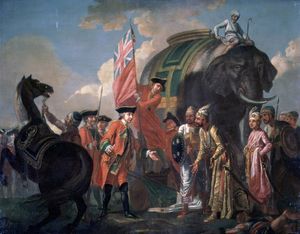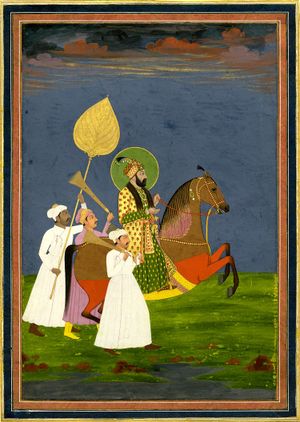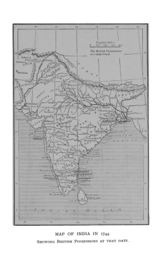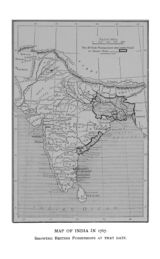معركة پلاسي
| ||||||||||||||||||||||||||||||||
معركة پلاسي (Battle of Plassey ؛ بالبنغالية: পলাশীর যুদ্ধ, Pôlashir Juddho) كانت نصراً حاسماً لـشركة الهند الشرقية البريطانية على نواب البنغال وحلفائه الفرنسيين[1] في 23 يونيو 1757. المعركة رسخت وجود الشركة في البنغال، ثم توسعت لاحقاً لتغطي معظم الهند في المائة عام التالية.
نشبت المعركة في پلاشي (ينطقها الإنگليز: پلاسي) على ضفاف نهر بهاگيراتي، على بعد نحو 150 كم شمال كلكتا وجنوب مرشد آباد، التي كانت عاصمة البنغال (والآن في ضلع ناديا في البنغال الغربية). المتقاتلون كانوا سراج الدولة، آخر نواب مستقل للبنغال، و \شركة الهند الشرقية البريطانية. وكان سراج الدولة قد أصبح نواباً على البنغال في العام السابق، وقد أمر الإنگليز أن يتوقفوا عن التوسع في تحصيناتهم . رشى روبرت كلايڤ مير جعفر، القائد العام لجيش النواب، كما وعده بأن يجعله نواب البنغال. وقد انتصر على النواب في پلاسي في 1757 واستولى على كلكتا.[2]
المعركة سبقها هجوم على كلكتا التي كانت تحت سيطرة البريطانيين من النواب سراج الدولة ومذبحة الحفرة السوداء. وقد أرسل البريطانيون تعزيزات بقيادة الكرنل روبرت كلايڤ والأدميرال تشارلز واتسون من مدراس إلى البنغال واستعادا كلكتا. ثم استغل كلايڤ المبادرة to للاستيلاء على الحصن الفرنسي في چندرنگر.[3] Tensions and suspicions بين سراج الدولة والبريطانيين culminated in the Battle of Plassey. The battle was waged during the حرب السنوات السبع (1756–63), and, in a mirror of their European rivalry، شركة الهند الشرقية الفرنسية (La Compagnie des Indes Orientales)[1] sent a small contingent to fight against the British. سراج الدولة had a numerically superior force and made his stand at Plassey. The British, worried about being outnumbered, formed a conspiracy with مع القائد المقال لجيش سراج الدولة، مير جعفر، مع آخرين مثل يار لطف خان، Jagat Seths (Mahtab Chand and Swarup Chand), Omichund وراي دورلاب. مير جعفر، راي دورلاب ويار لطف خان thus assembled their troops near the battlefield but made no move to actually join the battle. جيش سراج الدولة with 18,000 soldiers was defeated by 3,000 من جنود العقيد روبرت كلايڤ، وبفضل هرب سراج الدولة من ميدان القتال and the inactivity of the conspirators. The battle was ended in 40 minutes.
This is judged to be one of the pivotal battles in the control of شبه القارة الهندية by the colonial powers. The British now wielded enormous influence over the Nawab and consequently acquired large amounts of concession for previous losses and revenue from trade. The British further used this revenue to increase their military might ودفعت القوى الاستعمارية الاوروبية الأخرى مثل شركة الهند الشرقية الهولندية والفرنسية خارج جنوب آسيا، موسـّعة بذلك الامبراطورية البريطانية في آسيا.
خلفية
الحروب الكرناتية
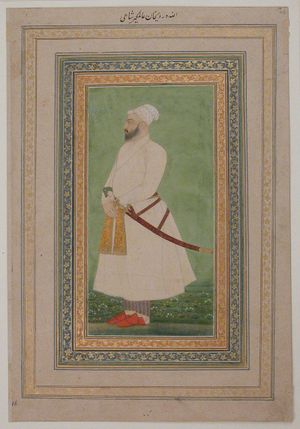
عليوردي خان ارتقى عرش نواب البنغال بعد أن هاجم جيشه عاصمة البنغال، مرشد آباد، واستولى عليها. Alivardi's attitude to the Europeans in Bengal is said to be strict. During his wars with the Marathas, he allowed the strengthening of fortifications by the Europeans and the construction of the Maratha Ditch in Calcutta by the British.
حملة البنغال


بالاضافة لذلك، فقد آمن سراج الدول أن شركة الهند الشرقية البريطانية لم تحصل على ترخيص من سلطان المغل عالمگير الثاني to fortify their positions في أراضي نواب البنغال.[4]
المؤامرة
The Nawab was infuriated on learning of the attack on Chandernagar. His former hatred of the British returned, but he now felt the need to strengthen himself by alliances against the British. The Nawab was plagued by fear of attack from the north by the Afghans under أحمد شاه دراني and from the west by the Marathas. Therefore, he could not deploy his entire force against the British for fear of being attacked from the flanks. A deep distrust set in between the British and the Nawab. As a result, Siraj started secret negotiations with Jean Law, chief of the French factory في قاسم بازار، and de Bussy. The Nawab also moved a large division of his army under Rai Durlabh to پلاسي، على جزيرة قاسم بازار 48 كم جنوب مرشد آباد.[5][6][7][8]
نسق المعركة
| الجيش الإنگليزي-الهندي (شركة الهند الشرقية) | |||
|---|---|---|---|
| الوحدة | القائد | Complement | |
| القائد العام | الكرنل روبرت كلايڤ | ||
| 1st Division (1st Madras European Regiment) | Maj. James Kilpatrick | ||
| 2nd Division (1st Madras & Bombay European Regiments) | Maj. Alexander Grant | ||
| 3rd Division (HM's 39th Regiment of Foot) | Maj. آير كوت | ||
| 4th Division (Bombay European Regiment) | Maj. George Frederick Guah (or Guapp) | ||
| Sepoys (1st Bengal Native Infantry) | 2100 | ||
| Artillery (9 Battery, 12th Regiment, Royal Artillery) | Lt. Hater Cpt. William Jennings |
150 (100 artillerymen, 50 sailors) 6 قطع ميدانية 2 هاوتزر | |
| جيش البنغال | |||
|---|---|---|---|
| Unit | القائد | Complement | |
| القائد العام | سراج الدولة | ||
| فرسان المقدمة | مير مردان موهان لال |
5,000 فرسان 7,000 مشاة | |
| الميسرة | مير جعفر | 15,000 فرسان 35,000 مشاة | |
| القلب | يار لطف خان | ||
| الميمنة | راي دورلاب | ||
| المدفعية | 53 قطعة (mostly 32, 24 and 18-pounders) | ||
| المدفعية الفرنسية | St. Frais | 50 رجل مدفعية فرنسي 6 قطع ميدانية | |
المعركة
بدء المعركة

مصرع مير مدان خان
المناورات الميدانية
العواقب
الآثار
السياسية
As a result of the battle of Plassey, the French were no longer a significant force in Bengal. وفي 1759, the British defeated a larger French garrison at Masulipatam, securing the Northern Circars. By 1759, Mir Jafar felt that his position as a subordinate to the British could not be tolerated. He started encouraging the الهولنديين to advance against the British and eject them from Bengal. In late 1759, the Dutch sent seven large ships and 1400 men from Java to Bengal under the pretext of reinforcing their Bengal settlement of Chinsura even though Britain and Holland were not officially at war. Clive, however, initiated immediate offensive operations by land and sea and defeated the much larger Dutch force on 25 November 1759 in the Battle of Chinsura. ثم أطاح البريطانيون بمير جعفر وعيّنوا محله مير قاسم كـنواب البنغال. The British were now the paramount European power in Bengal. When Clive returned to England due to ill-health, he was rewarded with an Irish peerage, as Lord Clive, Baron of Plassey and also obtained a seat in the British House of Commons.[9][10]
The struggle continued in areas of the Deccan and Hyderabad such as Arcot, Wandewash, Tanjore and Cuddalore, culminating in 1761 when Col. Eyre Coote defeated a French garrison under de Lally, supported by حيدر علي at Pondicherry. The French were returned Pondicherry in 1763 by way of the Treaty of Paris but they never again regained their former stature in India. The British would, in effect, emerge as rulers of the subcontinent in subsequent years.[11][12]
الاقتصادية
The Battle of Plassey and the resultant victory of the British East India company led to puppet governments instated by them in various states of India. This led to an unleashing of excesses, malpractices and atrocities by the British East India Company in the name of tax collection.[13]
This led to largescale detrimental impact on the economy of India (the Indian subcontinent). Research by Simmons (1985) and Harvard Scholars Clingingsmith and Williamson concluded that India's share of world manufacturing output fell from 24.5% in 1750 to a paltry 2.8% in 1880, 1.4% in 1913 and a 2.4% in 1938, based on earlier findings by Simmons (1985).[14]
انظر أيضاً
الهامش
- ^ أ ب [[[:قالب:Wdl]] "Memoirs of the Revolution in Bengal, Anno Domini 1757"]. World Digital Library. 1760. Retrieved 30 September 2013.
{{cite web}}: Check|url=value (help); Cite uses deprecated parameter|authors=(help) - ^ Robins, Nick. "This Imperious Company - The East India Company and the Modern Multinational - Nick Robins - Gresham College Lectures". Gresham Colelge Lectures. Gresham College. Retrieved 19 June 2015.
- ^ Naravane, M.S. (2014). Battles of the Honorourable East India Company. A.P.H. Publishing Corporation. p. 38. ISBN 9788131300343.
- ^ Rai, R. History. FK Publications. p. 44. ISBN 9788187139690. Retrieved 13 September 2015.
- ^ خطأ استشهاد: وسم
<ref>غير صحيح؛ لا نص تم توفيره للمراجع المسماةHBen - ^ Mahon, p. 337
- ^ Orme, p. 145
- ^ Malleson, pp. 48–49
- ^ Mahon, pp. 349–352
- ^ Harrington, p. 85
- ^ Harrington, pp. 85–88
- ^ Mahon, pp. 353–363
- ^ Simmons, Collin (1985). The Great Depression and Indian Industry: Changing Interpretations and Changing Perceptions. Cambridge: Cambridge University Press. Retrieved 29 July 2015.
- ^ Clingingsmith, David; Williamson, Jeffrey (2005). India's Deindustrialization in the 18th and 19th Centuries. Harvard, MA: Harvard University.
المراجع
- Stanhope, Philip H. (1853). History of England from the Peace of Utrecht to the Peace of Versailles (1713-1783). Vol. IV. Leipzig: Bernhard Tauchnitz. ISBN 1-4069-8152-4. OCLC 80350373.
- Orme, Robert (1861). A History of the Military Transactions of the British Nation in Indostan from the year MDCCXLV. Vol. II. Madras: Athenaeum Press. OCLC 46390406.
- Malleson, George B. (1885). The Decisive Battles of India from 1746 to 1819. London: W.H. Allen. ISBN 0-554-47620-7. OCLC 3680884.
- Harrington, Peter (1994). Plassey 1757, Clive of India's Finest Hour; Osprey Campaign Series #36. London: Osprey Publishing. ISBN 1-85532-352-4.
- Hill, S.C., ed. (1905). Bengal in 1756–1757. Indian Records. London: John Murray. ISBN 1-148-92557-0. OCLC 469357208.
للاستزادة
- Chaudhary, Sushil (2000). The Prelude to Empire: Plassey Revolution of 1757. New Delhi: Manohar. ISBN 81-7304-301-9.
- Datta, K.K. (1971). Siraj-ud-daulah. Calcutta: Sangam Books. ISBN 0-86125-258-6.
- Gupta, B.K. (1962). Sirajuddaulah and the East India Company. OCLC 1240808.
- Hill, S.C. (1903). The Three Frenchmen In Bengal: The Commercial Ruin of the French Settlements in 1757. London. ISBN 1-4264-4475-3.
{{cite book}}: CS1 maint: location missing publisher (link) - Marshall, P.J. (1987). Bengal - the British Bridgehead. Cambridge. ISBN 0-521-02822-1.
{{cite book}}: CS1 maint: location missing publisher (link) - Ray, Indrajit (2011). Bengal Industries and the British Industrial Revolution. Routledge. ISBN 1136825525.
- Spear, Thomas G.P. (1975). Master of Bengal - Clive and His India. London. ISBN 0-500-25041-3.
{{cite book}}: CS1 maint: location missing publisher (link) - Strang, Herbert (1904). In Clive's Command - A Story of the Fight for India. ISBN 1-4069-1756-7.
وصلات خارجية
- Hand coloured map of the battle from the London Magazine, printed circa 1760
- "Battle of Plassey". Murshidabad Official Website. Archived from the original on 22 May 2003. - basic map of the battlefield
- Mohsin, KM; Chaudhury, Sushil (2012). "Palashi, The Battle of". In Islam, Sirajul; Jamal, Ahmed A. (eds.). Banglapedia: National Encyclopedia of Bangladesh (Second ed.). Asiatic Society of Bangladesh.
- Robins, Nick (13 December 2004). "East India Company – The World's First Multinational". New Statesman. London.
- Pages using gadget WikiMiniAtlas
- CS1 errors: deprecated parameters
- CS1 errors: URL
- Coordinates on Wikidata
- Articles containing بنغالي-language text
- CS1 maint: location missing publisher
- نزاعات 1757
- معارك الممالك الهندية
- معارك البنغال
- معارك حرب السنوات السبع
- معارك بريطانيا العظمى
- معارك الهند البريطانية
- معارك شركة الهند الشرقية البريطانية
- معارك حملة الهند الشرقية (1757–1763)
- 1757 في الهند
- ضلع ناديا
- World Digital Library related
- تاريخ بنگلادش
